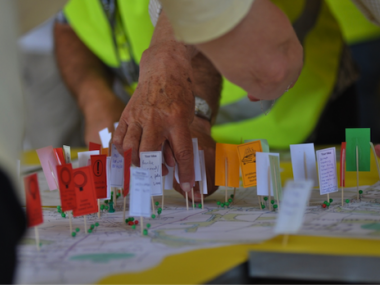Community-Led Local Development or How to Put People at the Center of Policy-Making
Edited on
04 February 2015Building a common view of what Community-Led Local Development (CLLD) means and supposes, sharing experiences related to participatory processes and the use of this tool in non-urban contexts and understanding the challenges of applying it to urban areas – here are the main objectives for the working seminar URBACT recently organized on the topic of Community-Led Local Development.

Following the seminar, we had the chance to exchange with Darinka Czischke, project manager for a wider URBACT study this seminar is part of that looks at New Concepts and Tools for Sustainable Urban Development in 2014-2020. Q: Darinka, which is in your opinion the element that characterizes best CLLD? A: First, it must be said that CLLD is the term used by the Commission to describe a new type of policy that is bottom-up, rather than top-down. Local people can form local partnerships that design and implement integrated strategies. No single group should have more than 49 % of the votes and non-public partners should have at least 50% of the votes. For this reason, CLLD is often described as a method or a tool but I would disagree with that. I believe that the main message to pass over is that CLLD is a way of doing things. It is another way to look at participation that requires a different mindset, where people are placed at the center of policy making. It is starting from a demand-side view of problems, drawing on the needs of the local people, where the local people are also in the driving seat. It should also be noted that CLLD is the only EU-wide programme where strategies are drawn and projects are selected by the locals. This represents a major paradigm shift, from “territoire guichet” to “territorire projet”, as Paul Soto, one of the main authors of the Guide on CLLD recently published by the EC, puts it. However, if we look at it in the context of regional and urban policies, CLLD is only a small part of the wide picture. For some funds, only 5% is earmarked for CLLD1. So we are still far away from transforming CLLD into the main paradigm, but we are working on it, we are at the beginning of a journey. Today we could see the wide diversity we had in the room in terms of understanding and also commitment to this approach and this seminar has been very useful to start building a common view. We also had a number of good cases, some pioneers I may say, like the City of Gotheburg (SE) or the Finish case from LEADER.
Q: How can cities and other local actors concretely use CLLD? A: The current model of CLLD has been developed and tested by some key EU programmes as LEADER or FARNET, while some others, like URBACT already contain elements of CLLD. Basically, 8 steps are needed to launch CLLD and the main principle is the iterative character of the entire process. The spiral diagram is a very good representation of this and it is something that can be applied to any kind of collective endeavor that requires the group to go together though a series of steps and re-visit their initial products. It also refers to an incremental way of achieving results, very similar to what we do in our normal lives – is starts small, but then the levels of detail and complexity increase and in the process you come back to the basics every once and a while and you might want to change or adjust something. Katy Wrathall on flickr. Guidelines on CLLD for Local Actors, p 14, for the spiral diagram.

1. For complete details of how CLLD is conceived within each ESI Fund, please consult the Guidance on Community-led Local development in European Structural and Investment Funds.
Read more:
Ten differences between Integrated Territorial Investments (ITI) and Community Led Local Development (CLLD) – URBACT blog Guidance on Community-Let Local Development in ESI Funds – EC, DG Regio website Guidance on Community-Let Local Development for Local Actors – EC, DG Regio website
Submitted by admin on
